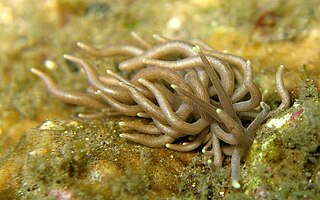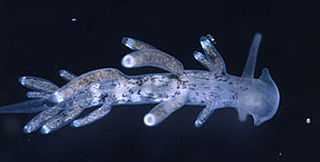
The Chromodorididae, or chromodorids, are a taxonomic family of colourful, sea slugs; dorid nudibranchs, marine gastropod mollusks in the superfamily Doridoidea. “Chromodorid nudibranchs are among the most gorgeously coloured of all animals.” The over 360 described species are primarily found in tropical and subtropical waters, as members of coral reef communities, specifically associated with their sponge prey. The chromodorids are the most speciose family of opisthobranchs. They range in size from <10mm to over 30 cm, although most species are approximately 15–30 mm in size.

Dotidae are a taxonomic family of small sea slugs, nudibranchs, shell-less marine gastropod molluscs formerly assigned to the order Opisthobranchia, but now considered to belong to the clade Dexiarchia. This family is unassigned to a superfamily.

Chromodoris annae is a species of sea slug, a very colourful nudibranch, a shell-less marine gastropod mollusc in the family Chromodorididae.

Phyllodesmium briareum is a species of sea slug, an aeolid nudibranch, a marine gastropod mollusc in the family Facelinidae.

Nembrotha cristata is a species of colourful sea slug, a polycerid nudibranch, a marine gastropod mollusk in the family Polyceridae. This species of sea slug is black with green markings; adults are around 50 mm in length, and they live on rock or coral reefs in the tropical Indo-West Pacific Ocean.

Phyllodesmium is a genus of predatory sea slugs, aeolid nudibranchs, marine gastropod molluscs in the family Facelinidae.

Phyllodesmium longicirrum, common name the solar-powered phyllodesmium, is a species of sea slug, an aeolid nudibranch, a marine gastropod mollusc in the family Facelinidae.

Cratena is a genus of sea slugs, aeolid nudibranchs, marine gastropod molluscs in the family Facelinidae.

Discodoris boholiensis, known commonly as the Bohol discodoris, is a species of sea slug in the family Discodorididae. It gets its name from the island of Bohol in the Philippines. Discodoris boholiensis has a distinctive pattern of chocolate brown and cream-white all over its flattened body and wavy-edged mantle. It reaches a length of 12 cm (5 in).

Phestilla melanobrachia is a species of sea slug, an aeolid nudibranch, a marine gastropod mollusk in the family Trinchesiidae.

Aeolidia is a genus of sea slugs, aeolid nudibranchs, marine gastropod mollusks in the family Aeolidiidae.

Tenellia is a genus of sea slugs, aeolid nudibranchs, marine gastropod mollusks in the family Trinchesiidae.

Phestilla is a genus of sea slugs, aeolid nudibranchs, marine gastropod molluscs in the family Trinchesiidae. Its members are unusual in feeding on hard corals, unlike other members of the family Trinchesiidae which feed on hydroids. Adult Phestilla have no cnidosacs. This genus has been investigated using DNA phylogeny and undescribed species exist.

The predaceous aeolis is a species of sea slug, an aeolid nudibranch, a marine heterobranch mollusc in the family Flabellinidae. This species was commonly known as Flabellina fusca, a junior synonym.
Phestilla sibogae is a species of sea slug, an aeolid nudibranch, a marine gastropod mollusk in the family Trinchesiidae. The species feeds on the hard coral genus Porites.

Phestilla minor is a species of sea slug, an aeolid nudibranch, a marine gastropod mollusk in the family Trinchesiidae. The species feeds on the hard coral genus Porites and has been found to represent a species complex.
Phestilla panamica is a species of sea slug, an aeolid nudibranch, a marine gastropod mollusk in the family Trinchesiidae. The species feeds on the hard coral genus Porites.
Phestilla poritophages is a species of sea slug, an aeolid nudibranch, a marine gastropod mollusk in the family Trinchesiidae. The species was named after its prey genus, the hard coral Porites.

Berthellina citrina, the orange gumdrop, is a species of sea slug in the family Pleurobranchidae. It is found in rock pools in the intertidal zone and in shallow water in the tropical and subtropical Indo-Pacific region.














